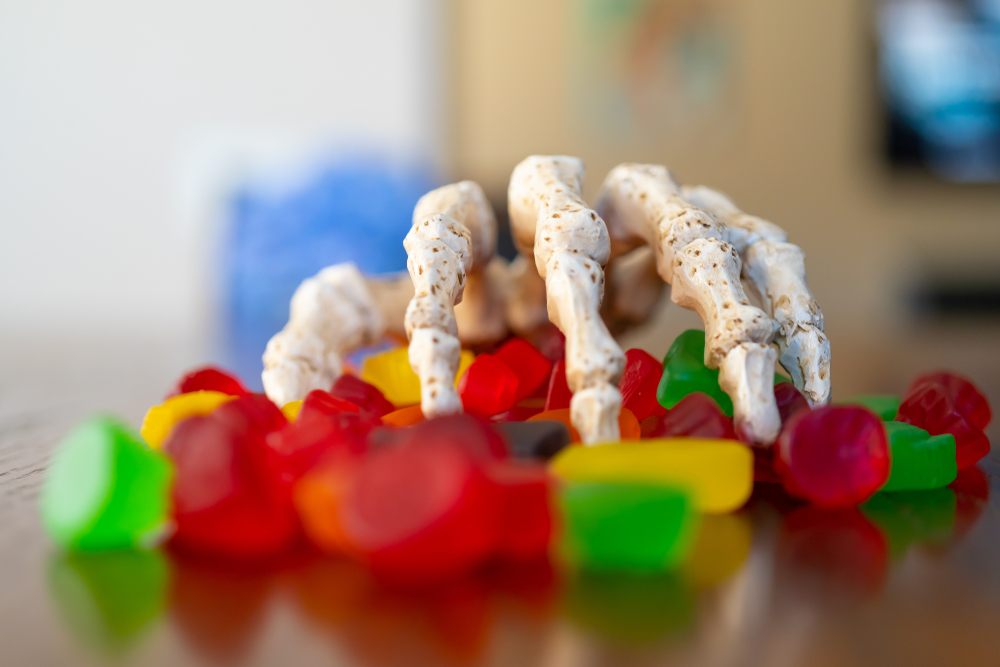
The Worst Halloween Candy Ingredients To Avoid (And What To Eat Instead!)
Armed with plastic pumpkins and spooky costumes, Halloween is the one night of the year when both kids and adults can let loose and have fun.
But how many of you dread the end of the night when the trick-or-treating is over and the candy wars begin?
Your kids want to eat all the candy they worked so hard to get, but you know those colorful bars contain health-robbing ingredients that will make your kiddos feel horrible. So what’s a parent to do?
Halloween is all about choices. What you choose your family tradition to be is what your kids will think is “normal”. At my house, we’ve talked about Halloween candy since my tribe was old enough to understand the difference between good ingredients and bad ingredients. They understand what processed sugar does to their bodies and know why it’s a bad choice to eat it. While they may roll their eyes at me when I launch into yet another conversation about how terrible processed sugar is, they get it and they make good food choices.
The thing is, you can have fun during Halloween with a little pre-planning, forethought, and frank conversations about food. The trick is to educate your kids about the foods they are putting into their bodies – why they are good or bad – and have a plan to swap their unhealthy candy for a treat that is equally tasty but much better for them.
Below are five harmful ingredients you can talk to your kids about before they’re staring at a pile of processed chocolates and their brains can no longer hear you. If you go online and look up some of the candies together before Halloween and talk about the harmful ingredients, this year when the costumes come off you shouldn’t be fighting that frustrating candy war.

5 Halloween Candy Ingredients to Avoid and What to Eat Instead
1 – Sugar, High Fructose Corn Syrup (HFCS), or Corn Syrup
Sugar causes heart disease, high blood pressure, high cholesterol, diabetes, obesity, premature aging, brain changes, mood changes, and many other negative health conditions as it affects essentially EVERY system in your body. It is more addictive than cocaine which makes it very difficult to stop eating it – you quite literally crave it. Other serious health problems, like fatty liver disease and type 2 diabetes (1, 2), can be caused by eating sugar. One shocking 3-week study showed that the overconsumption of sugar and fructose led to a whopping 27% increase in liver fat (3)!
High-fructose corn syrup is easily converted to fat (4) which long-term studies have shown leads to obesity. (5, 6) Additionally, it is made from GMO corn and there is a lot of controversy surrounding the safety of GMO foods. There are serious concerns regarding the side effects on the immune system, brain health, liver health, and cellular health.
What to eat instead? Look for products that contain non-glycemic or low-glycemic sweeteners like Stevia, birch Xylitol, Coconut Sugar, or mineral-rich Cane Juice Crystals. Raw honey or maple syrup are also beneficial nature-based sweeteners to feel good about eating. You can enjoy sweet products without dangerous long-term consequences.
2- Artificial Sweeteners
Sugar alternatives in the form of chemical sweeteners like aspartame and phenylalanine, while lower in calories than sugar, can be equally as dangerous to your health because they increase your risk for cardiovascular disease, type 2 diabetes, stroke, and dementia.
Aspartame is on the US Environmental Protection Agency (EPA) list of potentially dangerous chemicals that contribute to neurotoxicity as it contains three well-known neurotoxins. It has been associated with over 92 different side effects including brain tumors, birth defects, diabetes, and seizures.
Phenylalanine is a derivative of aspartame that blocks alkaline phosphatase (IAP) which is an enzyme in your digestive system. Blocking this important enzyme contributes to weight gain and obesity.
What to eat instead? As we mentioned above finding a non-gylcemic or low-gylcemic sweetener from a natural food source is always best. Additionally, you can look for inulin as a safe sweetener alternative.
3 – Artificial Colors
The Center for Science in the Public Interest (CSPI) published a detailed report in 2010 explaining the serious health implications of artificial food dyes including hyperactivity, allergies, and cancer. In fact, the report talks about the three most common dyes – Red 40, Yellow 5 and Yellow 6 – all containing cancer-causing ingredients. Red 3 does too. European lawmakers now require foods with artificial colors to come with a label warning that if eaten, the food “may have an adverse effect on activity and attention in children,” but in no such steps have yet been taken in the United States. (7)
What to eat instead? Look for products that are colored with vegetables and fruits. Beets, carrots, turmeric, spinach, and purple cabbage all lend pretty natural colors to foods without the toxic ingredients and side effects.
4 – Preservatives
Preservatives increase the shelf-life of packaged foods and preserve their natural characteristics so they maintain their nutrients and last longer. Unfortunately, because they are a man-made chemical, they also cause side effects that arguably cancel out their positive intention. Preservatives can cause allergic reactions, long-term allergies, headaches, heart palpitations, asthma, skin rashes, DNA damage, liver damage, and even some forms of cancer.
Here are some common preservatives to look out for: maltodextrin, modified food starch, caramel coloring or flavoring, citric acid, nitrates and nitrites, sodium nitrite, sorbate and sorbic acid, potassium sorbate, sodium sorbate, sodium benzoate and benzoic acid, monosodium glutamate (MSG), and natural flavorings.
What to eat instead: Rosemary extract is nature’s best preservative! Look for products that contain this natural ingredient that helps to maintain freshness. Also lemon juice, salt, and vinegar are natural preservatives.
5 – Hydrogenated or Partially-Hydrogenated Oils (Trans Fats)
A hydrogenated oil had healthy beginnings. It was once a vegetable oil that was mutated with the purpose of preventing rancidity of food. Unfortunately, while they do prevent food spoilage, these types of oils are incredibly toxic to our bodies. Our bodies don’t recognize them as being a mutated oil and so our cells take them in as if they were normal cellular food. They get incorporated into our cell membranes and disturb the chemical processes of the cells going forward. The Harvard School of Public Health notes that trans fats promote immune system overactivity and inflammation and are linked to heart disease, stroke, diabetes, and other chronic diseases. An article published in the “New England Journal of Medicine” notes that the average American consumes nearly 5 grams of trans fat per day — an amount that increases their risk for heart disease by approximately 25%.
What to Eat Instead: Coconut oil or extra-virgin olive oil are heart-healthy, body-healthy fats that truly nourish our cells especially our heart and brain.

Now that you know what ingredients to avoid, and some healthy alternatives to look for, here are 3 delicious and healthy recipes you can make at home before you go out trick-or-treating to “trade” all the processed candy for.
Wishing you a happy and healthy Halloween!

+ There are no comments
Add yours